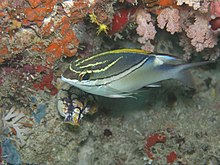Creek whaler
This small, stocky shark usually grows to 1.0–1.3 m (3.3–4.3 ft) long and is brownish in color without conspicuous fin markings.
A small number of creek whalers are caught incidentally in inshore gillnets and used for food, but the effect of fishing on its population seems to be inconsequential.
The creek whaler was described by Australian ichthyologist Gilbert Percy Whitley in a 1943 volume of Proceedings of the Linnean Society of New South Wales.
He assigned the new species to the subgenus Uranganops of the genus Galeolamna, and gave it the specific epithet fitzroyensis because the type specimen, a 1.2-m-long female, was collected from Connor's Creek in the Fitzroy River estuary.
The long snout has a narrowly parabolic shape and large nostrils preceded by small, nipple-shaped flaps of skin.
The upper teeth are long and triangular with strongly serrated edges, and become increasing angled towards the sides of the jaw.
The skin is densely covered by overlapping dermal denticles, each bearing three to five horizontal ridges leading to marginal teeth.
[13] Like other members of its family, the creek whaler is viviparous, with the developing embryos receiving nourishment from the mother through a placental connection formed from the depleted yolk sac.
[11] The newborns measure 35–50 cm (14–20 in) long and spend their first few months of life in shallow, inshore nursery areas such as Cleveland Bay in north Queensland.
[11] The creek whaler is a minor bycatch of inshore gillnet fisheries operating in northern Australia; the meat is sold for human consumption.
